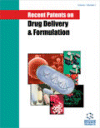- Home
- A-Z Publications
- Recent Patents on Drug Delivery & Formulation
- Previous Issues
- Volume 3, Issue 1, 2009
Recent Patents on Drug Delivery & Formulation - Volume 3, Issue 1, 2009
Volume 3, Issue 1, 2009
-
-
Drug Delivery Systems for Photodynamic Therapy
More LessAuthors: Ryan F. Donnelly, Paul A. McCarron and David WoolfsonPhotodynamic therapy (PDT) is a medical treatment in which a combination of a photosensitising drug and visible light causes destruction of selected cells. Over the past two decades, photodynamic therapy has enjoyed a period of intense investigation, both in the laboratory and in the clinic. Although still widely considered to be an experimental technique, its status and value within modern clinical practice continues to Read More
-
-
-
Chitosan and Its Use in Design of Insulin Delivery System
More LessBy Tin W. WongThe global burden of diabetes is estimated to escalate from about 171 million in 2000 to 366 million people in 2030. The routine of diabetes treatment by injection of insulin incurs pain and has been one major factor negating the quality of life of diabetic patients. The possibility of administering insulin via alternative routes such as oral and nasal pathways has been investigated over the years, but with insulin experi Read More
-
-
-
Trends in Pharmaceutical Taste Masking Technologies: A Patent Review
More LessAuthors: Zelalem Ayenew, Vibha Puri, Lokesh Kumar and Arvind K. BansalAccording to the year 2003 survey of pediatricians by the American Association of Pediatrics, unpleasant taste was the biggest barrier for completing treatment in pediatrics. The field of taste masking of active pharmaceutical ingredients(API) has been continuously evolving with varied technologies and new excipients. The article reviews the trends in taste masking technologies by studying the current state of the art pa Read More
-
-
-
Smart Polymers for Controlled Delivery of Proteins and Peptides: A Review of Patents
More LessAuthors: Laxmi R. Fogueri and Somnath SinghProtein and peptide-based therapeutic agents have unique physiochemical properties such as high molecular weight, short half life, requirement of a sustained plasma level for the desired therapeutic effect, liable to physical and chemical instability by gastric enzymes and harsh acidic environment as well as first pass metabolism, which makes their delivery a challenge. The delivery of proteins and peptides using variou Read More
-
-
-
Recent Advances in Oral Pulsatile Drug Delivery
More LessPulsatile drug delivery aims to release drugs on a programmed pattern i.e.: at appropriate time and/or at appropriate site of action. Currently, it is gaining increasing attention as it offers a more sophisticated approach to the traditional sustained drug delivery i.e: a constant amount of drug released per unit time or constant blood levels. Technically, pulsatile drug delivery systems administered via the oral route could be divid Read More
-
-
-
Site Specific Chronotherapeutic Drug Delivery Systems: A Patent Review
More LessAuthors: Nitin Saigal, Sanjula Baboota, Alka Ahuja and Javed AliOral dosage forms are known to provide a zero order or first order release in which the drug is released at a substantially steady rate of release per unit of time. However, there are instances where maintaining a constant blood level of a drug is not desirable. In such cases a pulsatile drug delivery may be more advantageous. Pulsatile drug delivery systems can be classified into site-specific systems in which the drug is rele Read More
-
-
-
CNS Drug Delivery Systems: Novel Approaches
More LessThe brain is a delicate organ, and nature has very efficiently protected it. The brain is shielded against potentially toxic substances by the presence of two barrier systems: the blood brain barrier (BBB) and the blood cerebrospinal fluid barrier (BCSFB). Unfortunately, the same mechanisms that protect it against intrusive chemicals can also frustrate therapeutic interventions. Despite aggressive research, patients suffering from f Read More
-
Most Read This Month
Article
content/journals/ddf
Journal
10
5
false
en


